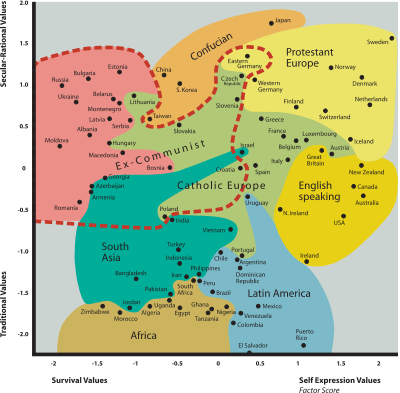Inglehart–Welzel cultural map of the world

The Inglehart–Welzel cultural map of the world is a map, or more precisely, a scatter plot created by political scientists Ronald Inglehart and Christian Welzel based on the World Values Survey. It depicts closely linked cultural values that vary between societies in two predominant dimensions: traditional versus secular-rational values on the vertical y-axis and survival versus self-expression values on the horizontal x-axis. Moving upward on this map reflects the shift from traditional values to secular-rational ones and moving rightward reflects the shift from survival values to self-expression values.
According to the authors: "These two dimensions explain more than 70 percent of the cross-national variance in a factor analysis of ten indicators—and each of these dimensions is strongly correlated with scores of other important orientations."[1]
The authors stress that socio-economic status is not the sole factor determining a country's location, as their religious and cultural historical heritage is also an important factor.[2]
Values
Analysis of the World Values Survey data by Inglehart and Welzel asserts that there are two major dimensions of cross-cultural variation in the world:
- x-axis: Survival values versus self-expression values
- y-axis: Traditional values versus secular-rational values.[1]
The map is not a geographical map but rather a chart in which countries are positioned based on their scores for the two values mapped on the x-axis (survival values versus self-expression values) and the y-axis (traditional values versus secular-rational values).[1] The map shows where societies are located in these two dimensions. Clusters of countries reflect their shared values and not geographical closeness.[1]
Traditional values emphasize the importance of religion, parent-child ties, deference to authority, absolute standards and traditional family values. People who embrace these values also reject divorce, abortion, euthanasia and suicide. Societies that embrace these values have high levels of national pride and a nationalistic outlook.[1]
Secular-rational values have the opposite preferences to the traditional values. Societies that embrace these values place less emphasis on religion, traditional family values and authority. Divorce, abortion, euthanasia and suicide are seen as relatively acceptable.[1]
The shift from traditional to secular-rational values has been described by Engelbrekt and Nygren as "essentially the replacement of religion and superstition with science and bureaucracy".[2]
Survival values place emphasis on economic and physical security.[1] They are linked with a relatively ethnocentric outlook and low levels of trust and tolerance.
Self-expression values give high priority to subjective well-being, self-expression and quality of life.[1] Some values more common in societies that embrace these values include environmental protection, growing tolerance of foreigners, gays and lesbians and gender equality, rising demands for participation in decision-making in economic and political life (autonomy and freedom from central authority), interpersonal trust, political moderation, and a shift in child-rearing values from emphasis on hard work toward imagination and tolerance.[1]
The shift from survival to self-expression also represents the transition from industrial society to post-industrial society, as well as embracing democratic values.[1][3]
Clusters
Countries can be divided into nine clusters: the English-speaking, Latin America, Catholic Europe, Protestant Europe, African-Islamic, Baltic, South Asian, Orthodox and Confucian clusters.[4] In previous studies, the African-Islamic cluster was split into two (the African cluster and the Islamic cluster) and the Baltic states did not have their own cluster. [5]
Another proposed way to cluster the societies is by wealth, with the poor societies at the bottom of both axes, and rich at the top.[6]
Country-specific analysis
Out of Western world countries, the United States is among the most conservative (as one of the most downwards-located countries), together with highly conservative Catholic countries such as Ireland and Poland.[7] Simoni concludes that "On the traditional/secular dimension, the United States ranks far below other rich societies, with levels of religiosity and national pride comparable with those found in some developing societies" (roughly, between Iran and Iraq).[3]
Asian societies are distributed in the traditional/secular dimension in two clusters, with more secular Confucian societies at the top, and more traditional South Asian ones at the center of the map.[8]
Russia is among the most survival-value oriented countries, and at the other end, Sweden ranks highest on the self-expression chart.[2]
It has also been found that basic cultural values overwhelmingly apply on national lines, with cross-border intermixtures being relatively rare. This is true even between countries with shared cultural histories. Additionally, even cultural clusters of countries do not intermix much across borders. This suggests nations are culturally meaningful units[9].
References
- 1 2 3 4 5 6 7 8 9 10 Ronald Inglehart; Chris Welzel. "The WVS Cultural Map of the World". WVS. Archived from the original on October 19, 2013. Retrieved 6 October 2014.
- 1 2 3 Kjell Engelbrekt; Bertil Nygren (18 March 2014). Russia and Europe: Building Bridges, Digging Trenches. Routledge. p. 32. ISBN 978-1-136-99201-8.
- 1 2 Serena Simoni (29 May 2013). Understanding Transatlantic Relations: Whither the West?. Routledge. p. 1. ISBN 1-136-47695-4.
- ↑ "WVS Database". www.worldvaluessurvey.org. Retrieved 9 November 2017.
- ↑ Robert Westwood; Gavin Jack; Farzad Khan; Michal Frenkel (29 August 2014). Core-Periphery Relations and Organization Studies. Palgrave Macmillan. pp. 64–65. ISBN 978-1-137-30905-1.
- ↑ Ronald Inglehart; Christian Welzel (8 August 2005). Modernization, Cultural Change, and Democracy: The Human Development Sequence. Cambridge University Press. p. 57. ISBN 978-1-139-45988-4.
- ↑ Helmut K Anheier; Yudhishthir Raj Isar (27 March 2007). Cultures and Globalization: Conflicts and Tensions. SAGE Publications. pp. 243–245. ISBN 978-1-84860-737-8.
- ↑ Michael A. Witt; Gordon Redding (23 January 2014). The Oxford Handbook of Asian Business Systems. OUP Oxford. p. 370. ISBN 978-0-19-162655-5.
- ↑ Michael Minkov; Geert Hofstede "Is National Culture a Meaningful Concept?", accessed 06/08/2017
External links
| Wikimedia Commons has media related to Inglehart–Welzel cultural map of the world. |
- "Inglehart-Welzel Culture Map – Business Insider". Business Insider. 3 July 2014. Retrieved 6 October 2014.
- "WVS: Findings and Insights". WVS. Retrieved 6 October 2014.
- A video showing changes over time on a similar map